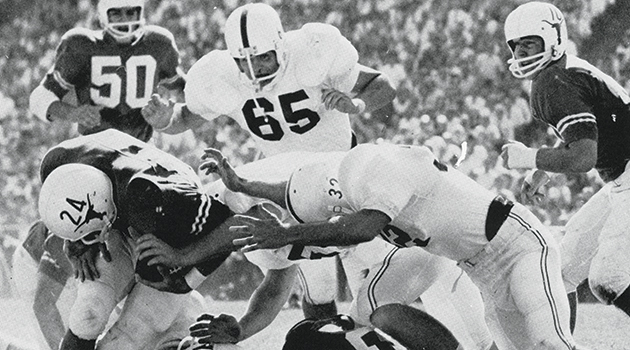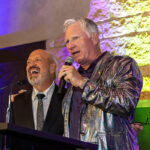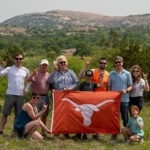The Spirit of ’63
Fifty years ago, the Texas Longhorns won their first national championship, despite doubts and outright derision from the national media. We take a look back at the year that introduced Coach Royal’s team to the world.
On Sept. 12, 1962, President John F. Kennedy stood on the campus of Rice University in Houston and announced his intention to send American astronauts to the moon. “But why, some say, the moon?” he asked rhetorically. “Why choose this as our goal? And they may well ask why climb the highest mountain. Why, 35 years ago, fly the Atlantic? Why,” he finished with intent, “does Rice play Texas?”
A little more than a month later, the top-ranked Texas Longhorns left a sold-out Rice Stadium, having played the unranked Owls to a 14-14 draw. The 73,000 spectators, along with the rest of the nation, were stunned.
Just more than a year later, on Nov. 22, 1963, the Longhorns were once again the top team in the nation. They earned the top spot by defeating Oklahoma at the Cotton Bowl, and they were a week away from playing archrival Texas A&M at Kyle Field. The team was playing with intensity, and up to Coach Darrell K Royal’s exacting standards.
But by 1 p.m. that day, no one was thinking about football.
On CBS, Longhorn Walter Cronkite, ’33, Life Member, Distinguished Alumnus, announced the news that President Kennedy had been killed in Dallas. Lyndon B. Johnson, the barnstorming Texan, was now president of the United States. The season, now marred and changed, went on. The Longhorns played A&M on a field so muddy that UT regent Frank Erwin, LLB ’48, Life Member, Distinguished Alumnus, threatened to commandeer the public address system just to chastise the Aggies. Even in the muck and the darkness, the team moved forward with a narrow, messy win, 15-13.

Returning to the Cotton Bowl to play second-ranked Navy on New Year’s Day, Royal’s squad was the nominal national champion. The skillful combo of players like future UT head coach David McWilliams, BA ’64, Life Member; Scott Appleton, BS ’67; and quarterback Duke Carlisle, BBA ’65, MBA ’66, Life Member, had bent opponents to their will all season through a series of tough, low-scoring games. It was, back then, a more defensive game, not the high-flying, high-scoring aerial barrage that characterizes college football today.
But the Navy game, despite the rankings, was necessary for the Longhorns to secure their title. That game, played in a town then dubbed the “City of Hate,” pitted the state where the president was killed against the U.S. Naval Academy and its all-American, Heisman-winning, crew cut-sporting quarterback Roger Staubach. Sportswriters back east still doubted the parochial athletic backwaters of the South and West, and perhaps without knowing it, gave Texas something to prove. Myron Cope, a Pittsburgh commentator, was particularly incensed that a team from Texas of all places could ever be better than the midshipmen of Navy.
“Texas,” Cope wrote, “is the biggest fraud ever perpetrated on the football public.”
The famously stoic Royal, who often underplayed his hand when addressing the public, responded simply.
“We’re ready,” he insisted.
He was right. The Longhorns routed Navy, 28-6, sending “Jolly” Roger Staubach back to Annapolis, and proving their worth to the doubters. But it wasn’t just the aircraft carrier-sized weight of Navy they lifted off their shoulders—it was also the memory of Rice the year before, and Texas Christian University before that, and 70 years of regional wins and national near misses. After seasons of struggle and moderate success, the Longhorns had finally arrived, and opened the door for more to come. Texas, just like Coach said, was ready.
Top, Tommy Ford, BS ’65, Life Member, powers ahead against Oklahoma. Inset, Duke Carlisle, BBA ’65, MBA ’66, Life Member, oumaneuvers Navy. Photos from the Cactus Yearbook.


















1 Comment